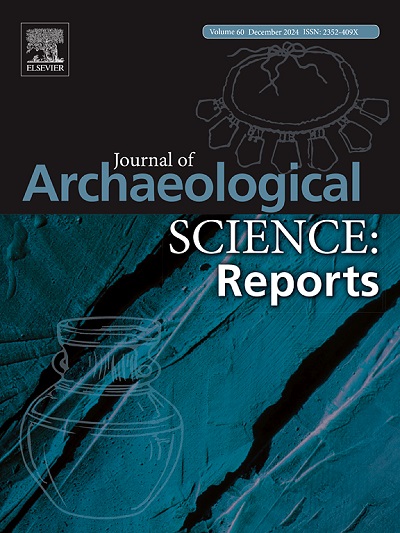作为贝壳堆季节性标志的浮游动物贝壳氧同位素:新石器时代晚期至中世纪早期莫莱纳群岛(法国布列塔尼)的情况
IF 1.5
2区 历史学
0 ARCHAEOLOGY
引用次数: 0
摘要
海洋软体动物碳化壳的稳定氧同位素比值(δ18O)被广泛用作古温度计,因为该比值的主要驱动因素是碳酸盐沉淀时的温度(加上盐度)。这种方法也用于人为贝壳冢,作为过去人类活动及其使用海洋资源的替代物:从贝壳边缘重建的海面温度可以解释为制造贝壳冢的人采集贝壳的季节。为了更好地了解伊鲁瓦兹海和莫莱纳群岛(法国菲尼斯泰尔省)的居住模式和史前采集贝类的习俗,我们分析了两个岛屿贝壳冢内新石器时代晚期(LN,公元前 2570 - 2140 年)、青铜时代早期(EBA,公元前 2140 - 1740 年)和中世纪早期(EMA,公元前 620 - 820 年)居住的跛足贝(Patella sp.)的季节性数据:该方法使我们能够区分贝尼盖岛遗址的季节性和永久性占用,丰富了考古观察的内容。我们的研究结果还表明,在这两个岛上,最大的贝壳冢全年都有贝壳采集,这证实了对这些地区的持续占领,尽管全年的采集强度并不均衡。在贝尼盖岛和莫莱纳岛,以及在利恩岛和东巴岛上,采集最多的季节是冬末和春季,这表明采集活动在加强,以弥补冬末的资源枯竭。这些结果完善并加强了这些遗址之前已有的季节性数据,表明不仅分析贝壳的数量,而且贝壳在淤泥中的空间分布也会影响季节性的解释。现在需要通过确定淤泥中其他资源的季节性指标来完善这一方法,从而真正掌握这些过去的岛国居民的国内经济情况。本文章由计算机程序翻译,如有差异,请以英文原文为准。
Limpet shell oxygen isotopes as markers of seasonality in shell middens: The case of Molène Archipelago (Brittany, France) from Late Neolithic to Early Middle Age
The stable oxygen isotopes ratio (δ18O) from marine mollusk carbonated shells is widely used as a palaeo-thermometer, as the main driver of this ratio is the temperature (coupled with the salinity) at which the carbonate precipitated. This method is also used on anthropogenic shell middens, as a proxy for past human practices and their use of marine resources: the Sea-Surface Temperature reconstructed from the shell margin can be interpreted as the season during which the people who produced the midden collected the shells. To better understand the occupation patterns and protohistoric practices of shellfish collection in the Iroise Sea and the Molène archipelago (Finistère, France), we analyzed seasonality data of limpets (Patella sp.) from Late Neolithic (LN, 2570 – 2140 cal. BCE), Early Bronze Age (EBA, 2140 – 1740 cal. BCE) and Early Middle Age (EMA, 620 – 820 cal. CE) occupations within shell middens of two islands: Molène and Béniguet.
The methodology allowed us to discriminate seasonal and permanent occupations for Béniguet Island site, enriching archaeological observations. Our results also show that the largest shell middens yield all year round collection, on both islands, confirming the continuous occupation of these territories, despite uneven intensity of collection throughout the year. The most represented seasons are late winter and spring, both on Béniguet and Molène islands, and for LN and EBA suggesting an intensification of collection to compensate resource depletion toward the end of winter. These results complete and enhance the previous seasonality data existing on these sites demonstrating here that not only the number of analyzed shells but also their spatial distribution within the midden can impact the seasonality interpretation. This approach now needs to be completed by the determination of seasonality indicators on the other resources present in the middens, to truly grasp the domestic economies of these past insular populations.
求助全文
通过发布文献求助,成功后即可免费获取论文全文。
去求助
来源期刊

Journal of Archaeological Science-Reports
ARCHAEOLOGY-
CiteScore
3.10
自引率
12.50%
发文量
405
期刊介绍:
Journal of Archaeological Science: Reports is aimed at archaeologists and scientists engaged with the application of scientific techniques and methodologies to all areas of archaeology. The journal focuses on the results of the application of scientific methods to archaeological problems and debates. It will provide a forum for reviews and scientific debate of issues in scientific archaeology and their impact in the wider subject. Journal of Archaeological Science: Reports will publish papers of excellent archaeological science, with regional or wider interest. This will include case studies, reviews and short papers where an established scientific technique sheds light on archaeological questions and debates.
 求助内容:
求助内容: 应助结果提醒方式:
应助结果提醒方式:


